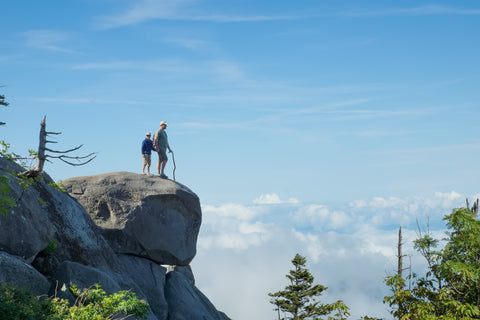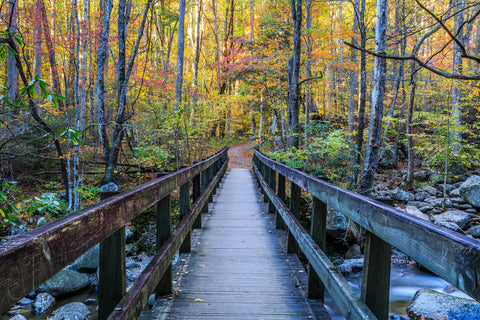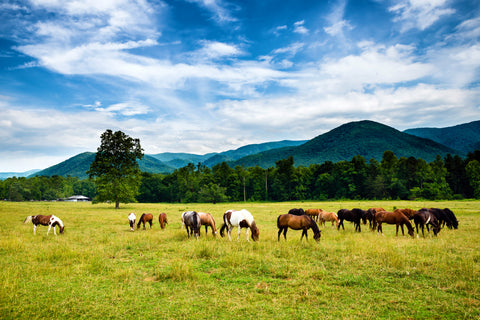Where is Great Smoky Mountains National Park
Straddling the border of Tennessee and North Carolina, in the thick of gorgeous Appalachia, you’ll find Great Smoky Mountain National Park. The land is a rich and lush forest with wildflowers that bloom year-round. Streams and rivers snake through the forests. Waterfalls and wildlife are abundant. To the south is Nantahala National Forest. Pisgah National Forest lies to the east. Great Smoky Mountain National Park is only about an hour from Knoxville, TN. The park is about three and a half hours away from Atlanta, GA.

How Big is Great Smoky Mountains National Park
Great Smoky Mountain National Park rests relatively evenly between North Carolina and Tennessee. The park covers more than 520,000 acres, or about 800 square miles. The lowest point in the park is at the mouth of idyllic Abrams Creek, 875 feet. Clingmans Dome is the peak at 6,643 feet. There are sixteen fantastic peaks measuring over 6,000 feet in the park. The total mileage of trails and unpaved roads in the park equals 850 miles, the same distance between Boston and Detroit.
Great Smoky Mountains National Park Weather
Weather in the mountains can be swift and unpredictable. There can be vast differences between the valleys and peaks. Summer is a popular time for the park. The weather in the valleys is hot and humid with gorgeous, cooler weather as you ascend. The heat and moisture bring a serious summer haze that hangs off the mountains. Thunderstorms are frequent. Fall is the most popular time to watch the forest foliage change. The days are picturesque, ranging from 60 to 80°F, and the nights are cool. The haze is dispersing and there are less storms. Freezing temperatures start rolling in towards November. Winter is fairly mild but chilly, though there can be significant snowfall on the peaks. Springs are warm and brilliant. Wildflowers burst to life and animals are active in this US National Park.

When did Great Smoky Mountains become a National Park
The formation of Great Smoky Mountain National Park took the effort of thousands. The land that is now the park was once owned by many small farmers, logging operations and paper companies. The Great Smoky Mountain became a park on June 15, 1934. President Roosevelt formally dedicated the park on September 2, 1940 at the Rockefeller Memorial at Newfound Gap.

Things to do in Great Smoky Mountains National Park
There are plenty of things to do at Great Smoky Mountain National Park. Our National Park Visitors Guide highlights some of the most popular adventures and the best time to give them a try.
Clingmans Dome
The highest point in the park, and in Tennessee, is Clingmans Dome at 6,643 feet. This round-topped relic offers gorgeous views from the futuristic observatory deck. Drive to the half-mile scenic walk spring through fall. In winter, when the road is closed, only cross-country skiers can reach the summit.
Fall Foliage
There are over 100 species of trees in the park. When the leaves change in fall, the forest erupts in a brilliant display of autumn colors. It is a stunning spectacle that brings in visitors. Mid-September is prime for higher-elevation trees, mid-October for lower ones.
Fontana Lake
If you want to get out on the water, Fontana Lake is perfect. There’s 240 miles of shoreline. Bring the kayak, canoe or paddle board. You can rent a boat in Fontana Village. The best time to get on the lake is spring and summer.
Appalachian Trail
The Appalachian Trail stretches 2,190 miles, with 71 of them bisecting Great Smoky Mountains National Park. Hike through thick forests and around beautiful waterfalls over rugged mountain trails. The park has broken the Appalachian Trail into several smaller day hikes for short stay vacationers.
Waterfalls
In spring and summer seasons, the waterfalls at the park cascade fiercely. There are more than 100 spectacular waterfalls to see. Some you can drive to. The others are reachable via hiking trails. The four most popular are Rainbow, Grotto, Abrahams and Mouse Creek Falls.
Fishing
There’s no shortage of fishing opportunities in the park with dozens of lakes and more than 2,900 miles of streams. Fishing is permitted year-round in all streams. The waters are teeming with brook, rainbow, and brown trout. You’ll also find rockbass and smallmouth bass.
Animals in the Great Smoky Mountains
The wilderness of the Great Smokys is home to many animals, chiefly birds, mammals and amphibians. There are about 2 black bears per park square mile. Elk and deer are prominent, especially in spring and fall. More than 30 species of salamander inhabit the park.
Camping at the Park
Camping is the most popular thing to do at the park, no matter the season (though summer is the busiest). There are backcountry campgrounds for backpackers. Frontcountry campsites feature cool, running water and amenities. There are also spacious group campgrounds and lots of horse camps.

Pioneer History
The park is rife with remnants from its pioneer roots. There are over 90 buildings from the 1800s still standing. Tour the Mountain Farm Museum. Explore homes, schools, churches, mills and more. Spring, Summer and Fall are all great times to visit these historic sites.
Hiking Trails in the Great Smoky Mountains
Every season in the Great Smokys has something to offer hikers; spring wildflowers, summer streams, fall foliage and winter snow. There are short day hikes to multi-day backpacking trails. Be sure to check the weather in your area and bring a map before heading out.

When to go to Great Smoky Mountains National Park
The Great Smoky Mountains are majestic and serene any time of year. No matter what season you visit, you’re sure to have a great time and a spectacular view. The most popular seasons for the park are fall and summer. July and October are the busiest months of the year. The waterfalls and waterways are at their peak levels. The fall foliage starts to change colors around mid-September, a beautiful time for hiking. Springtime is also popular for hikers. It’s great for folks looking to spot wildlife and see wildflowers. If you want winter snow, come during January, February and early March. Build snowmen, go cross-country skiing, take the tour of lights, or participate in holiday festivities. Note that some areas close during the winter.
Must-Have things to bring to Great Smoky Mountains
List of Parks suggest a few key items that you should really bring with you on your trip to Great Smoky Mountain National Park. We have outlined the most important supplies below:
Water
If you’re going sightseeing or hiking in the park, you need to bring water. The humidity is very dehydrating. A water bottle is recommended. For longer trips, consider investing in a hydration filtration system to use on stream water - replenish your supply as you go.
Food/Snacks
Keep yourself fueled while you are adventuring. The food and grocery options in the park are very limited. You’ll want to bring your own meals as well as snacks. Trail mix, jerky, granola and veggies are great. Keep food sealed tight in bear boxes overnight.
Sturdy Hiking Boots
You’ll be traversing some tricky terrain in the Smoky Mountains. To keep your feet safe, bring along sturdy hiking boots. They’ll prevent sprains, cuts and blisters. You’ll want them to be broken in, as well as waterproof and breathable. Extra socks are always a plus.
Rain Jacket
Rain showers and thunderstorms are very common in the park. Staying dry while on a long trek is important to avoid hypothermia. Make sure you pack a good rain jacket that will keep you dry and warm. Avoid water resistant jackets and opt for fully waterproof.
Multiple Clothing Layers
The temperature and weather can differ quite drastically between valleys and peaks. You’ll want to pack and wear several light layers. You will want more clothing at the colder, higher elevations. As you descend in elevation, you can always remove layers as you warm up.
Sunglasses, Sunscreen and a Hat
The sun is a force, and it is only stronger the higher you climb. You will need to bring sunglasses and a hat to keep the sun off your face and out of your eyes. Wear sunscreen to protect your skin from harmful ultraviolet rays.
Binoculars
It is never a bad idea to pack some binoculars. You can use them to take in the breathtaking scenery, spot elusive animals like elk and black bears, or for some serious birdwatching. Campers and hikers should invest in a high quality, lightweight pair of binoculars.
Headlamp
It gets incredibly dark in the backcountry of the Great Smokys. You can see tons of stars at night but the trail not so much. A good headlamp will save you from skinned knees and stumbling around camp. Plus, they’re great for spotting nocturnal critters.
Bug Spray
Ticks, flies, beetles, bees, wasps and mosquitos call the park home. Don’t let insects and other pests spoil your vacation! Bring some bug spray or another insect repellent to keep those bothers at bay. For the least amount of insect activity, visit in early spring.
Park Maps
Great Smoky National Park is huge. The trails are tricky and the forests are thick. It’s never a bad idea to bring a map. A physical copy is a must; print ahead of time or grab at the park. A backup map on your phone is a good idea too!
Where to stay in Great Smoky Mountains National Park
There are dozens of options for staying in the incredible Smoky Mountains. The park features numerous campgrounds that can accommodate tent campers and RVs. There is one lodge and cabins. However, these spots fill up fast! Book well in advance. There are also plenty of backpacking sites for those hiking through Appalachia. Around the park there are plenty of hotels, bed and breakfasts, condos, cabins, or rentals to choose - especially in Pigeon Forge and Gatlinburg.
Food Nearby Great Smoky Mountains
The towns around Great Smoky Mountain National park serve up hot, fresh and delicious cuisine. There are some options for eating and groceries in the park, but they are limited. There is a camp store and concessions, as well as a few beverage vending machines in the stables. It is best to bring a good selection of food with you.
Airports near Great Smoky Mountains National Park
There are four convenient airports adjacent to Great Smoky Mountain National Park. The closest is in Tennessee, south of Knoxville, McGee-Tyson Airport. Greenville-Spartanburg International Airport in South Carolina is a good choice at 2 hours away. Charlotte Douglas International Airport is only an hour away and Asheville Regional Airport around two and half hours. Both are located in North Carolina.

